I created 2 PDF files that contain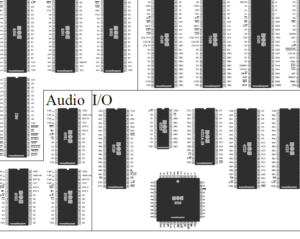 a lot of IC and Connector pinouts.
a lot of IC and Connector pinouts.
The files are created for A3 paper size.
The files can be downloaded here:
Feel free to download and use them.
I often use chip 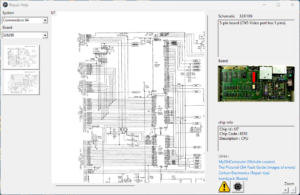 pinouts and schematics when I repair computers.
pinouts and schematics when I repair computers.
For this I normally search on my website, but sometimes I need files or information that I don’t have on my site.
So I created a little program to help me with this task.
The program is build as a repair tool that holds several schematics and chip pinouts. When hovering the mouse over the schematics, you see the location of the chip on the PCB image.
When hovering the mouse over the schematics, you see the location of the chip on the PCB image.
Clicking on the chip will (generate and) show the pinout of the chip.
All schematic info and pinout info is stored as a text file,  so new schematics and pinouts can be added.
so new schematics and pinouts can be added.
The program has some issues, but I’m not a programmer.
If you’re a programmer and would like to take over the “Repair Help” project, please contact me.
The Repair Tool can be downloaded “here” and is for windows 7 and up (needs .net 5.0 runtime), use is at own risk.
One of the parts that fails a lot on a Commodore 64 is the power switch.
After 40 years the contacts of those switches seems to get oxidated or dirty.
The correct switch is hard to find, or sold for to much money.
One solution is to open the switch, careful bend the metal shield away of the plastic housing.
Then clean the contacts and reassemble.
Only disadvantage of this is that the plastic can crack and reassembly of the switch can be a hassle.
There is another trick…
You can order a switch almost the same as used in the Commodore 64, and swap the black knob.
when you search on the internet for a TR-80 switch, you see that those switches are very common, but the knob is to large.
The knob does have the same mounting as the Commodore power switch, so when you can swap the knobs, so you have a “new” switch with correct knob.
When you buy a Commodore SX 64, sometimes the keyboard cable is missing.
This is a issue as the cable doesn’t have standard connectors.
while the BD-sub 25 connector pinout fits, the commodore connector, the housing and mounting holes at both sides won’t fit.
a lot of users that are missing the cable are building one with flat cable connectors and “shave” off the “ears” of the connector, to make a replacement cable that fits.
flowerking published a 3d model of the connector that could be printed on Thingiverse.
scottpav enhanced the design so the plastic from a normal connector could be used inside the 3d printed shells
Since I also own a SX 64 without cable, I decided to order the connector parts. (JLCPCB as an shop that sells 3d printed objects).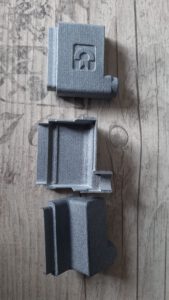
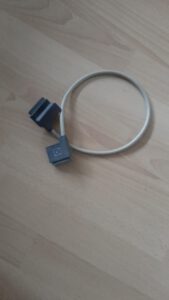 so after uploading the design, JLCPCB returned with a remark that thickness was less than 1mm and that could be an issue in the end result.
so after uploading the design, JLCPCB returned with a remark that thickness was less than 1mm and that could be an issue in the end result.
I took responsibility as thicker shell would probably not fit.
after 2 weeks, I received the connector shells.
I started soldering the cable to two 25 pin DB-sub connectors, and removed the metal shield from the connectors.
Then I assembled the connectors with some hot glue, and tested the end result.
The cable worked as it should, and is much better looking that the flat cable solution.
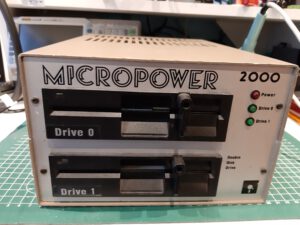 Over a year ago I bought a strange Dual floppy drive.
Over a year ago I bought a strange Dual floppy drive.
The drive is called Micropower 2000 and was build by “Analog Digital”.
On the internet I couldn’t find a lot info, I only found some info on the website of Richard Lagendijk <Here> .
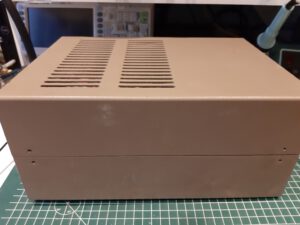 He also had a hard time getting more info on the drive.
He also had a hard time getting more info on the drive.
The difference between our drives are the markings on the front of the drive.
First I thought it could be a prototype of the MSD SD2 As the drives have a lot in common.
To test I programmed 2 eprom’s with the firmware of the MSD and placed them in the drive, and it still functioned.
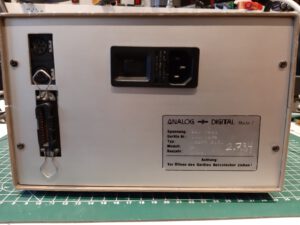 To get some more info about the drive I created a thread on forum64 <Here> to see if someone else had more info about the drive, but till today there is no reply.
To get some more info about the drive I created a thread on forum64 <Here> to see if someone else had more info about the drive, but till today there is no reply.
One thing I know now is that the drive can’t be a prototype as the MSD SD2 was introduced in 1983 and my Micropower 2000 is produced in 1984.
So I think it’s a clone.
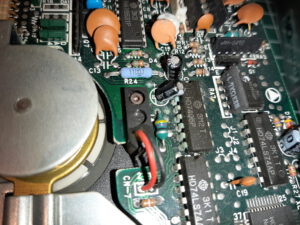 On use the drive is responding and loading most floppies, but has some issues while formatting and loading of long files.
On use the drive is responding and loading most floppies, but has some issues while formatting and loading of long files.
As the Micropower 2000 uses the same drive units I searched the web and ended on the page of Ray Carlsen <Here> and found that the drive units have capacitors that will leak over time.
After disassembling the drive I could clearly see some corrosion on both drive units.
I ordered a new set of capacitors to replace them, and will start replacing them soon.
Other things that needs to be done is:
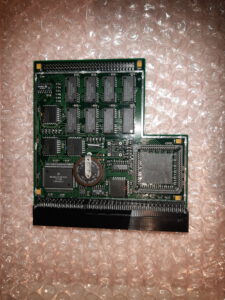 I’m saving to buy a new digital oscilloscoop, so I decided to sell so stuff that I don’t use anymore.
I’m saving to buy a new digital oscilloscoop, so I decided to sell so stuff that I don’t use anymore.
So last weekend I put my Blizzard 1220/4 and 2 old (to big for my desk) oscilloscopes for sale.
The Blizzard was one of two cards that came with my A1200, and I never use it as the other card is a GVP 68030 at 40 MHz and contains 16 Mb fast memory.
So if you are interested in a 68020 running at 28MHz and 4Mb fast memory expansion card for the A1200 go to Amibay. SOLD
I created a small guide on how to flash a Gotek drive Without the use of a USB to RS232 converter.
You can find it here
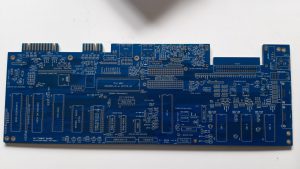 last week I received 2 prototype boards called “64 Tuning Board”.
last week I received 2 prototype boards called “64 Tuning Board”.
This is a design of Matthias that he showed on Forum64.de.
This board is designed to use an Arduino or teensy and has several other “expansions” like the option to use sram over dram which does not show the VSP bug.